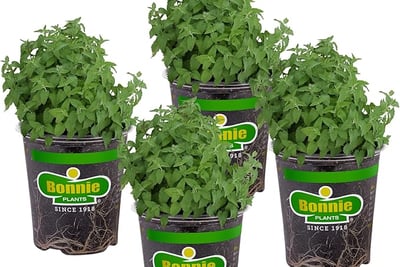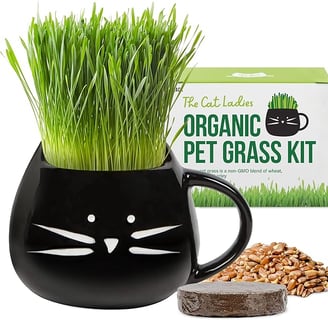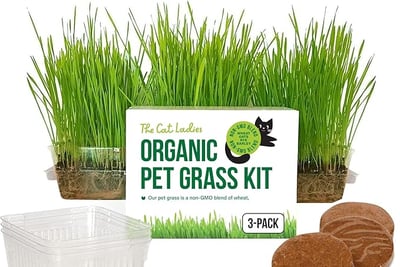How to Grow Cat Grass & Other Pet-Safe Greens
8 min read


Introduction to Pet-Safe Greens
Incorporating pet-safe greens into the diets of our furry companions has become increasingly recognized as a fundamental aspect of ensuring their health and wellbeing. While traditional pet food may provide essential nutrients, the addition of greens offers a variety of benefits that can enhance overall health. These plants not only provide a natural source of vitamins and minerals, but they also play a key role in promoting digestive health and preventing common ailments among pets.
One of the primary advantages of including greens in a pet's diet is the incorporation of fiber, which aids in digestion and can help maintain a healthy weight. Greens such as cat grass and wheatgrass are particularly beneficial as they encourage healthy chewing behaviors and can deter pets from nibbling on non-edible houseplants. Moreover, many pets enjoy the taste and texture of these greens, making them a delightful treat that can stimulate their appetite.
When selecting pet-safe plants, it is essential to consider not only the nutritional value but also the types of plants that are safe for your particular pet. Certain greens, such as basil and parsley, are not only safe but also provide potential therapeutic effects, such as anti-inflammatory properties. However, it is crucial to avoid plants that are toxic to pets, as some common houseplants can cause health issues if ingested. Proper research and understanding of which plants are safe will aid pet owners in making informed choices that align with their furry friends’ dietary needs.
Overall, incorporating pet-safe greens into your pet's routine can foster a healthier lifestyle while also satisfying their natural instincts. As we explore the cultivation and care of these greens, it is important to appreciate their role in enhancing our pets' quality of life.
Choosing the Right Types of Greens for Pets
When selecting appropriate greens for pets, it is essential to consider options that contribute positively to their health and well-being. One of the most popular choices is cat grass, which typically comprises a variety of grasses such as wheatgrass or oat grass. These types of greens are particularly beneficial for cats as they offer essential vitamins and minerals while aiding digestion. Additionally, cat grass provides a natural outlet for pets to engage in chewing behavior, which can help prevent hairballs and support oral health.
Wheatgrass, another excellent choice, is rich in vitamins A, C, and E, as well as minerals such as iron, calcium, and magnesium. This pet-safe green is not only nutritious but can also improve overall vitality and immune function. Including wheatgrass in your pet’s diet can be a rewarding experience, as its high chlorophyll content plays a role in detoxification, promoting a healthier digestive system.
Other suitable herbs that you can safely introduce to your pets include parsley, basil, and cilantro. Parsley is an excellent source of vitamins K and C, while basil has anti-inflammatory properties, and cilantro can help promote liver health. These herbs can be used in moderation to enhance your pet's diet and can easily be grown at home or sourced from local stores. Growing your own pet-safe greens can be an enjoyable activity that allows you to control the growing conditions, ensuring a pesticide-free product for your pets.
When choosing greens, it is advisable to avoid those that are toxic to pets, such as chives and onion greens. Always conduct thorough research or consult a veterinarian for guidance to ensure the safety and health of your pet. By carefully selecting and introducing the right types of greens, you can provide a balanced nutritional supplement that complements your pet's overall diet.
Materials Needed for Growing Cat Grass
Growing cat grass is a rewarding and enriching activity for pet owners, allowing them to provide their feline companions with a natural source of enjoyment. To successfully cultivate cat grass, a few essential materials and tools are required. Understanding these elements is crucial to ensuring healthy growth and vibrant greenery.
First and foremost, quality potting soil is vital for planting cat grass. Look for soil that is well-draining and organic, as this will provide the necessary nutrients while preventing waterlogging that can lead to root disease. A mixture designed for indoor plants works well, but make sure it is free from harmful additives.
Containers are another important item. You may choose traditional pots, seed trays, or even recycled containers as long as they provide adequate drainage. Ensure that the container has holes at the bottom to allow excess water to escape, which will help maintain optimal moisture levels for the grass.
Seeds specifically labeled for cat grass, such as wheatgrass, barley, or oat seeds, are essential. Purchase seeds from reputable suppliers, as high-quality seeds will germinate more reliably and produce healthier plants. It is advisable to check for freshness and suitable packaging to ensure viability.
Proper lighting is also crucial for successful germination and growth. If natural sunlight is limited, consider using grow lights to provide the necessary brightness for the seeds to flourish. Place the light source close and ensure it mimics natural day lengths, typically around 12-16 hours of light per day.
Lastly, a watering can or a spray bottle will facilitate gentle watering without overwhelming the soil. Frequent, light watering is best until the seeds sprout, after which the watering schedule can be adjusted based on the plants' needs. By assembling these materials with care, you will lay a promising foundation for growing vibrant cat grass that your pet will love.
Step-by-Step Guide to Growing Cat Grass
Growing cat grass is a straightforward process that provides not only a nutritious treat for your feline friend but also an enjoyable gardening experience. The following step-by-step guide outlines the essential techniques, including optimal planting methods, watering schedules, and appropriate lighting conditions to guarantee healthy growth.
To start, gather the required supplies: cat grass seeds (commonly wheatgrass, oat grass, or barley grass), a shallow pot or tray with drainage holes, potting soil, and a watering can or spray bottle. Fill the pot with potting soil, leaving about an inch of space at the top. Optionally, you may want to sterilize the soil to eliminate any pests or diseases.
Next, sprinkle the seeds evenly across the surface of the soil. A light covering of soil over the seeds helps ensure adequate moisture retention, which is crucial for germination. After planting, gently press down on the soil to secure the seeds in place.
Water the soil thoroughly but ensure it is not soggy, as excess water can lead to seed rot. A spray bottle is ideal for gently misting the soil to maintain adequate moisture without overwhelming the seeds. Place the pot in a warm location that receives indirect sunlight. Ideally, you should aim for a temperature range of 65-75°F (18-24°C) for optimal germination.
Within 7 to 10 days, you should observe the seeds sprouting. Once the grass reaches about 2-4 inches in height, typically around two to three weeks after planting, it is ready for your cat to enjoy. At this point, continue watering the grass lightly as needed, ensuring the soil remains moist but not drenched. Regularly trimming the grass encourages new growth, allowing your pet to indulge in fresh greens continuously.
By following these detailed steps, you will provide a wholesome, pet-safe green treat that enhances your cat’s well-being and satisfies their natural cravings. Enjoy the process of nurturing both the grass and your beloved pet.
Other Pet-Safe Plants: Cultivation and Care
In addition to cat grass, several other pet-safe plants can be cultivated at home, enriching your pet's environment while ensuring their safety. Herbs such as basil, parsley, and rosemary not only provide health benefits for your pets but also enhance the flavor profile of your culinary dishes. Understanding the cultivation and care requirements of these plants is essential for successful growth.
Basil, a popular herb in many households, is not only safe for pets but also quite easy to grow. It thrives in bright, indirect sunlight and requires well-drained soil. When watering, it’s crucial to ensure the top inch of soil dries out between waterings to prevent root rot. Additionally, regular trimming will promote bushier growth and a lusher appearance.
Parsley, another safe herb for pets, is rich in vitamins and beneficial nutrients. This biennial plant prefers full sun and needs consistent moisture, making it essential to water it regularly. However, care should be taken not to overwater, which can harm the plant. Harvesting parsley regularly can encourage new growth and keep the plant vibrant.
Rosemary is a hardy perennial that can be grown indoors or outdoors, provided it receives ample sunlight. It requires well-draining soil and is quite drought-tolerant, making it an excellent choice for those who may be less consistent with watering. Young rosemary plants benefit from frequent pruning, which helps shape the plant while encouraging new growth.
When cultivating these pet-safe plants, it's important to monitor for pests and diseases, as a healthy plant is less likely to pose a risk to your pets. Regularly inspect your plants for any signs of distress and address any issues promptly. Providing these green spaces not only promotes the well-being of your pets but also offers a delightful addition to your home environment.
Troubleshooting Common Growth Issues
Growing cat grass and other pet-safe greens can be a rewarding experience, yet it may come with its fair share of challenges. Understanding these common growth issues and their solutions can help ensure a successful gardening endeavor. One of the primary problems that gardeners encounter is mold growth, which typically occurs in overly damp conditions. To combat this, it’s essential to provide adequate drainage for the growing medium and avoid excessive watering. Additionally, consider placing the pots in a well-ventilated area to minimize humidity and promote air circulation around the plants.
Another widespread issue is overwatering, which is not only detrimental to the roots but can also lead to mold and fungal infections. Ensuring your pots have drainage holes allows excess water to escape, while using a moisture meter can help gauge the water needs of your plants accurately. When in doubt, it is usually better to underwater than overwater. Also, observing the plants for signs of distress, such as yellowing leaves, can help you adjust your watering schedule timely.
Pests pose another significant threat to cat grass and similar plants. Common intruders like aphids or spider mites can hinder growth and can be deterred by regularly inspecting your plants. Should you notice pest activity, using a gentle insecticidal soap or a mixture of water and dish soap can be effective in getting rid of them without harming the plants or your pets. Lastly, if germination rates seem poor, ensure that you are using fresh seeds and providing them with the right temperature and moisture levels necessary for sprouting.
By addressing these common growth issues proactively, you can create a thriving environment for your cat grass and other pet-safe greens, ensuring a healthy and enjoyable experience for both you and your furry friends.
Harvesting and Serving Pet Greens
Harvesting cat grass and other pet-safe greens at the appropriate time is crucial for ensuring the best flavor and nutritional value for your furry friend. The ideal moment to harvest typically occurs when the grass reaches around six inches in height. At this stage, the leaves are tender and packed with nutrients, making them most appealing for your pet. When cutting the grass, use sharp scissors or shears to snip the leaves, ensuring you cut just above the soil level. This technique encourages regrowth, allowing for multiple harvests from the same plant.
It’s important to introduce greens gradually into your pet's diet. Start with small servings to allow your pet to acclimate to the new texture and taste. Monitor their reaction closely, as some pets may take time to adjust to consuming fresh greens. Offering a small handful of freshly harvested greens once or twice a week can be beneficial. Be sure to observe your pet during this period, as some pets might experience gastrointestinal discomfort when consuming new foods.
To enhance your pet's meals, consider creative ways to serve cat grass and other greens. You can finely chop the greens and mix them into your pet's regular food, or you can offer them as a standalone treat during training sessions. Another option is to blend these greens into homemade pet treats or incorporate them into wet food for a nutritional boost. Remember to also provide plenty of fresh water alongside any greens, as hydration is essential for your pet’s well-being. By following these simple guidelines for harvesting and serving pet greens, you can ensure a tasty and healthy addition to your pet's diet.











